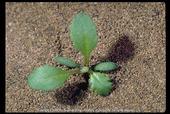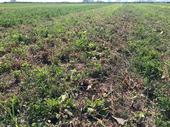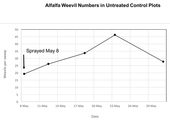- (Focus Area) Pest Management
- Author: Thomas Getts
- Author: Rachael Freeman Long
- Author: Lynn M. Sosnoskie

As you're thinking about winter weed management in alfalfa production, keep in mind the need for common groundsel control.
Groundsel (Senecio vulgaris) is highly toxic to livestock at all growth stages because it contains pyrrolizidine alkaloids (PA) which can cause chronic and irreversible liver disease in animals. Cattle and horses are most sensitive to the PAs, followed by pigs and chickens, and then sheep, goats and turkeys, which are the least sensitive to PA toxicity. Younger animals are typically more sensitive than adults. Therefore, the identification and control of groundsel in forages is important for preventing livestock PA poisonings.
What is...
- Author: Lynn M. Sosnoskie
- Author: Thomas Getts
- Author: Rachael Freeman Long
- Author: Mariano Galla

The first step in developing a successful weed management program is being able to properly identify the species that are infesting a field. But why? Why is weed identification so important? Simply stated, because not all weeds are created equal. Species differ with respect to their emergence timing, life history traits, competitive interactions with the crop, potential to harm livestock, and sensitivity to available herbicides, among many other characteristics. Consequently, the type and timing of weed control events need to be designed to target problematic species so that control is maximized, weed seed return to the soil seedbank is minimized, and crop yields are protected.
Unfortunately, weed identification is not always a...
- Author: Thomas Getts
- Author: Lynn M. Sosnoskie
- Author: Rachael Freeman Long
- Author: Mariano Galla
- View More...

The old saying, “Everything's fine until it's not,” comes to mind when dealing with some tough to control perennial weeds in alfalfa production during the summertime. Such was the case for an alfalfa field in the Sacramento Valley, where weed control seemed good up until mid-summer, and then it wasn't. Perennial weeds that started off small and overlooked, grew through the season, persisting through multiple cuttings, including curly dock, plantain, and nutsedge. For tough to control weeds in alfalfa fields, one needs to determine: 1) What types of perennial weeds are present, and 2) How many of them are there, to make a decision on how to manage them. These sorts of weed issues can creep up quickly in older alfalfa...
- Author: Thomas Getts
- Author: Rachael Long

Picture 1: Adult alfalfa weevil
Alfalfa weevils, key pests of alfalfa hay, have been showing pyrethroid insecticide resistance within the Intermountain region, specifically in the Scott Valley area west of Mount Shasta. In some alfalfa fields, weevil counts have been off the charts with 100 weevils per sweep, FIVE times the economic threshold level. These same fields showed little efficacy on weevil control by pyrethroids. In a 2016 test only 3-15% of weevils collected from conventional fields died from exposure to pyrethroids. Weevils collected from organic alfalfa fields that had no exposure to pyrethroids showed a 92% mortality (



